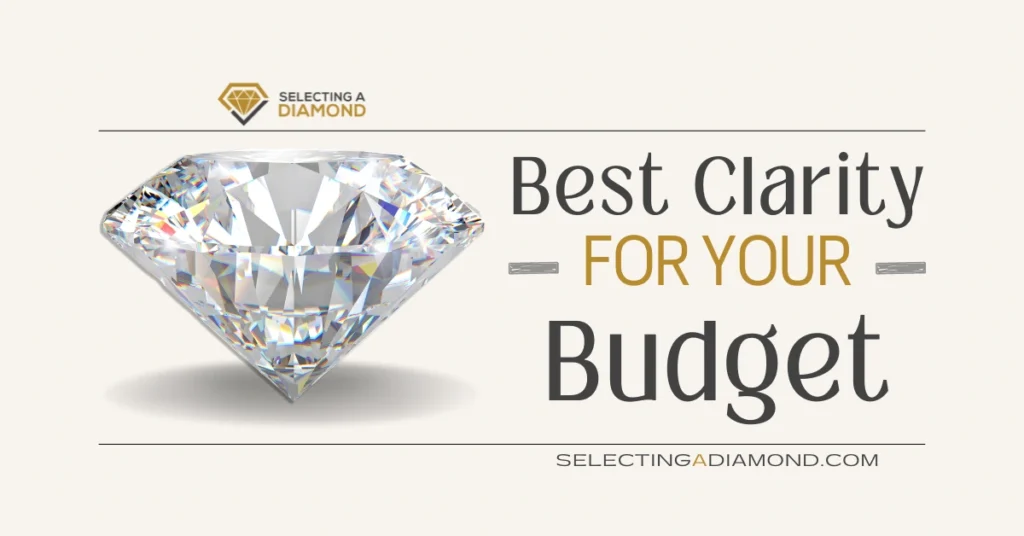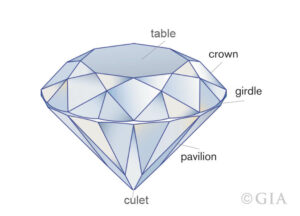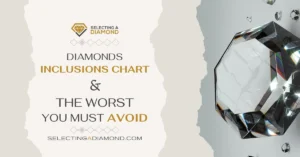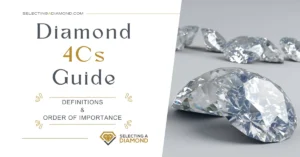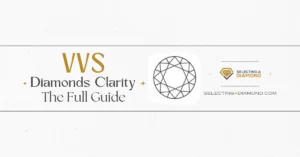While it might be tempting to aim for the highest clarity grade, the reality is that you don’t necessarily need a Flawless (FL) or Internally Flawless (IF) diamond to have a beautiful, brilliantly shining stone.
The ideal clarity grade to aim for will largely depend on your budget, the size of the diamond, and your personal preferences, among other factors.
Let’s take a look at two diamonds:

Exclusively looking at clarity, can you choose one over the other? Keep in mind that both diamonds have the same carat, color, cut, polish, and symmetry properties. Also, remember these images have a 20x magnification.
The diamond on the left, with VS1 clarity, is available on Blue Nile for $5321. If you’re ready to shell out an extra $500 for a characteristic that you (or anyone else for that matter) won’t be able to tell, you could go for the diamond on the right.
While the simple answer might be, “Just aim for the highest possible clarity and you’re good to go,” let’s ask a more refined question:
What clarity grade should I go for that ensures I’m getting a top-notch, brilliantly sparkling diamond?
This question is more specific and that’s what we aim to answer. A number of diamond store reps might seize this opportunity to upsell you the highest clarity grade they’ve got. Let’s find out the right answer so you can avoid any pitfalls when shopping for diamonds.
Understanding Diamond Clarity
Let’s take a look at two diamonds: this VVS1 1 Carat diamond on James Allen, priced at $5930, and this similar SI1 diamond, priced at $4690.
Apart from clarity, these diamonds have identical carat, color, cut, polish, symmetry, and neither exhibits fluorescence.
This discrepancy in price, a surplus of over $1200 (a +26% increase), purely due to clarity is the key reason why it’s vital to understand why we choose a particular clarity grade. This knowledge ensures that we are receiving the best possible value for our expenditure.
Before we delve deeper, it’s important to comprehend how clarity is gauged. What distinguishes a VS grade diamond from a VVS grade one?
The concept of diamond clarity is an inclusive one, indicating the presence or absence of flaws or blemishes inside or on the surface of a diamond, and assessing their significance.
A diamond’s clarity is contingent on the number of inclusions or blemishes it contains, and how noticeable these flaws are, whether to the naked eye or under a loupe.
How Inclusions Affect Clarity
Diamonds are created deep within the earth’s crust, where blemishes and inclusions naturally take place. Blemishes refer to the flaws on the diamond’s surface, while inclusions are the internal defects.
Diamonds with fewer flaws are more likely to demonstrate brilliance and better light reflection. This is because the light that traverses through the diamond is not impeded by any inclusions or blemishes within or on the diamond.
The position of a flaw also influences the diamond’s clarity. Defects that are near the girdle or around the bezel facets are less likely to be visible, hence such diamonds are regarded as having superior clarity.
On the other hand, inclusions on the diamond table are more probable to be noticeable and/or affect the diamond’s light reflection, depending on the type and size of the inclusion.
Until the mid-20th century, a standardized classification of a diamond’s defining characteristics didn’t exist; diamonds were differentiated based on a simplified color system. The question, “What is the clarity of a diamond?” was seldom posed.
Thanks to the Gemological Institute of America (GIA) in the 1960s, the diamond industry and consumers acquired a better understanding of what constitutes a perfectly cut diamond, resulting in the increased demand for such diamonds.
The GIA introduced a reference system to the world, appraising a diamond according to four key characteristics:
- Cut
- Color
- Carat
- Clarity
The GIA clarity grades are derived from an 11-point system that considers the number, size, color, reflectivity, and position of a diamond’s flaws or inclusions.
Choosing a Suitable Diamond Clarity Level
Diamonds are classified into 11 categories, with 6 (and sometimes a 7th) being eye-clean. This implies that any defects can only be observed under a 10x magnification.
Internally Flawless (IF) / Flawless (FL)
IF diamonds have surface blemishes that are exceptionally challenging to identify even with magnification. Flawless (FL) diamonds do not possess any blemishes or inclusions and are extremely rare, accounting for less than 2% of all diamonds.
Very Very Slightly Included (VVS1. VVS2)
These diamonds contain inclusions so minor that they are challenging to identify even under 10x magnification.
Very Slightly Included (VS1, VS2)
These diamonds contain minor inclusions that are scarcely visible under 10x magnification. These diamonds may possess clouds, feathers, and crystals that reduce their clarity.
Slightly Included (SI1, SI2)
Inclusions such as clouds, feathers, knots, crystals, and cavities can be distinctly observed under a jeweler’s loupe in SI1 and SI2 diamonds. For SI2 diamonds, these inclusions may be visible to the naked eye.
Included (I1, I2, I3)
These diamonds have evident inclusions that can be seen with the naked eye and are more prominent under magnification. Despite their flaws, these diamonds are still sold as some customers prioritize other attributes more than clarity.
The Best Diamond Clarity for Your Budget?
The simple answer to the best clarity grade for your budget is to select a diamond that is “Eye Clean.”
Elaborating on this, your goal should be to acquire a diamond without any noticeable inclusions and to make sure no significant inclusions are on the table.
Your choice will also be influenced by personal preferences – whether you’re seeking uniqueness, being budget-conscious, or prioritizing safety. Above all, aim to get the best value for your money.
Choosing the Right Diamond Clarity for You
Understanding different clarity grades will facilitate your decision making. Here’s a breakdown:
IF-FL & VVS: Choose these grades if budget is not a concern. They offer high-quality diamonds that are near perfection, albeit at a significant price and rarity.
VS: Ideal for those seeking quality within a somewhat flexible budget. As the inclusions are invisible to the naked eye, this clarity grade is excellent. However, the higher VS grades can be pricey, and the additional cost may not necessarily improve the diamond’s clarity and brilliance.
SI1: If you’re considering an average carat diamond (1-1.5), an SI1 clarity grade might be enough. At this grade, inclusions are visible only under magnification and usually do not impact the diamond’s brilliance.
Remember, the location of imperfections matters too. If they’re on the diamond’s side, it’s more favorable than if they’re located in the center of the table.
Priceless or Flawless?
The ideal diamond clarity isn’t about obtaining the highest grade, but rather what fits your desires and budget.
Diamonds of varying clarity grades can look identical once set and worn, with blemishes and inclusions indistinguishable to the naked eye, visible only under magnification. If a completely flawless diamond isn’t essential to you, selecting a diamond within the SI1-VS2 grades is a savvy choice.
Choosing a lower clarity grade, that won’t visibly affect the diamond’s beauty, can be a wiser decision than overspending on a high clarity grade undetectable without magnification.
An “eye-clean” diamond, one where inclusions aren’t visible to the naked eye, can blur the distinction between varying diamond clarity grades. Diamonds graded SI1 and above are considered eye-clean as their imperfections aren’t detectable without magnification.
For added assurance, the VS2 grade offers excellent value for money without compromising on visible clarity. Don’t let retail stores persuade you otherwise.
Consider these three diamonds listed on James Allen, each an Ideal cut, 1.00 Carat, and E color. The only variable is the clarity:
This example shows you’ll pay a 25% premium for the VVS1 clarity, although the difference between it and the VS1 is virtually undetectable without magnification.
Summary
In conclusion, consider an eye-clean SI1 for a balance between clarity and cost. Online retailers like James Allen and Blue Nile allow you to examine real images and 360-degree videos of diamonds, helping you avoid any potential issues.
For extra assurance, though not always necessary with a clean SI1, you could go one grade higher: a VS2.
If your budget allows, prioritize a higher Cut—the most important factor of the 4Cs. If you have extra funds, allocate them towards Color, then consider a higher Clarity if still within budget.
Still not sure where to buy your diamond?
We always recommend shopping diamonds online and created a Full guide to shop diamonds like a Pro.
Among online retailers, here are our favorite stores click their logo to visit store
-
James Allen:
Our favorite online store, best diamond imaging technology available today, comes with the largest collection with more than half a million loose diamonds.
-
Blue Nile:
Widest collection of loose diamonds of all sizes, great imaging technology for most of their inventory (hundreds of thousands of diamonds), great customer support.
-
Whiteflash:
Home Of A CUT ABOVE® Super Ideal Diamonds, they stand out from the crowd by offering premium diamonds cuts, tailored to those who love the details, at great prices too.

